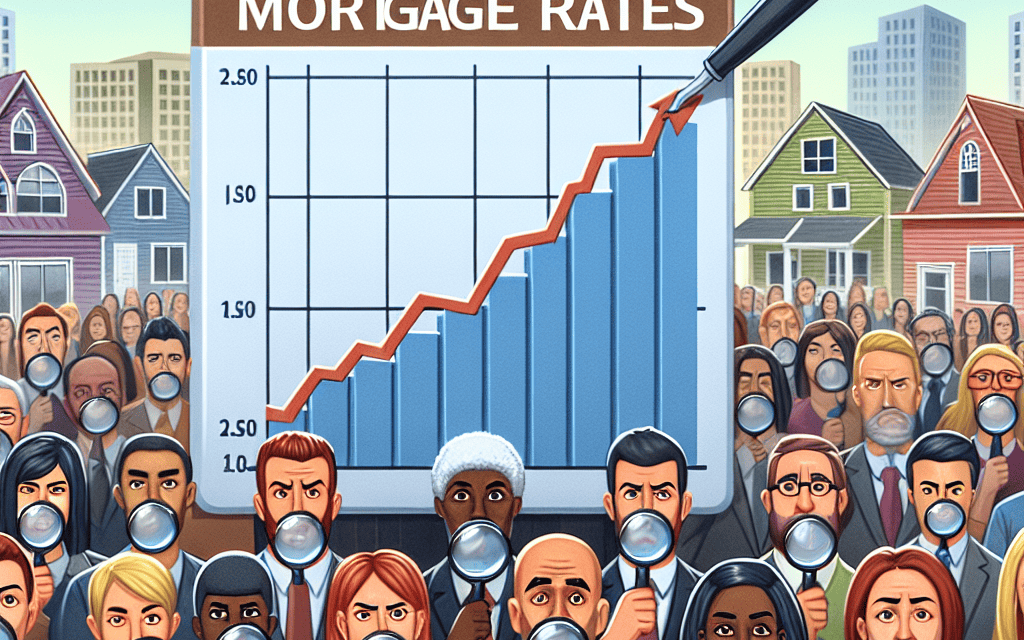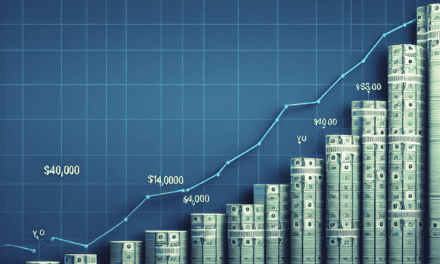“Rising Mortgage Rates: Proceed with Caution, Plan with Precision.”
Introduction
Mortgage rates have once again experienced an upward trajectory, stirring caution among prospective homebuyers. This latest increase in borrowing costs comes amid a backdrop of economic uncertainty and fluctuating financial markets, compelling many potential buyers to reassess their purchasing power and financial strategies. As lenders adjust their offerings in response to these changes, the housing market faces renewed challenges, with affordability and accessibility becoming central concerns for those looking to enter or move within the market. The rise in mortgage rates not only impacts individual purchasing decisions but also has broader implications for the real estate sector and the overall economy.
Impact Of Rising Mortgage Rates On First-Time Homebuyers
The recent uptick in mortgage rates has become a significant concern for first-time homebuyers, who are already navigating a challenging housing market. As interest rates climb, the cost of borrowing increases, making homeownership less affordable for many individuals. This development has prompted a wave of caution among potential buyers, who must now reassess their financial readiness and long-term plans. Understanding the implications of rising mortgage rates is crucial for first-time buyers as they consider entering the housing market.
To begin with, higher mortgage rates directly impact the monthly payments that homebuyers must make. Even a slight increase in interest rates can lead to a substantial rise in monthly mortgage payments, which can strain the budgets of first-time buyers. For those who are already stretching their finances to afford a home, this additional burden can be a deterrent. Consequently, many potential buyers may choose to delay their purchase until rates stabilize or decrease, hoping to secure a more favorable financial situation.
Moreover, rising mortgage rates can affect the overall affordability of homes. As borrowing costs increase, the amount of money that buyers can afford to spend on a home decreases. This situation can lead to a reduction in purchasing power, forcing first-time buyers to adjust their expectations and potentially settle for smaller or less desirable properties. In some cases, individuals may find themselves priced out of certain markets altogether, particularly in areas where home prices have already surged.
In addition to affecting individual buyers, rising mortgage rates can also influence the broader housing market. As demand from first-time buyers diminishes, the pace of home sales may slow, leading to a potential cooling of the market. This shift can have a ripple effect, impacting sellers who may need to adjust their pricing strategies to attract buyers. Furthermore, a slowdown in the housing market can have broader economic implications, affecting industries related to real estate, such as construction and home improvement.
Despite these challenges, there are strategies that first-time homebuyers can employ to navigate the current landscape. One approach is to explore different types of mortgage products that may offer more favorable terms. For instance, adjustable-rate mortgages (ARMs) often start with lower interest rates compared to fixed-rate mortgages, although they carry the risk of rate increases in the future. Additionally, buyers can consider improving their credit scores, as higher credit scores can lead to better mortgage rates and terms.
Another strategy is to increase savings for a larger down payment, which can reduce the overall loan amount and potentially lower monthly payments. First-time buyers may also benefit from seeking guidance from financial advisors or real estate professionals who can provide insights into market trends and help identify opportunities for cost savings.
In conclusion, the rise in mortgage rates presents a formidable challenge for first-time homebuyers, necessitating careful consideration and strategic planning. While the current environment may seem daunting, understanding the implications of rising rates and exploring available options can empower buyers to make informed decisions. By remaining vigilant and adaptable, first-time homebuyers can still achieve their goal of homeownership, even in the face of rising mortgage rates.
Strategies For Homebuyers To Navigate Increasing Mortgage Rates
As mortgage rates continue their upward trajectory, prospective homebuyers find themselves navigating an increasingly complex financial landscape. This rise in rates, driven by a combination of economic factors such as inflationary pressures and monetary policy adjustments, has prompted many potential buyers to exercise greater caution. In this environment, it is crucial for homebuyers to adopt strategic approaches to mitigate the impact of rising mortgage costs and make informed decisions.
One effective strategy is to enhance one’s financial profile before entering the housing market. By improving credit scores, potential buyers can secure more favorable loan terms, even in a high-rate environment. Paying down existing debts, ensuring timely bill payments, and avoiding new credit inquiries are practical steps that can lead to a better credit rating. Consequently, a higher credit score can translate into lower interest rates, which can significantly reduce the overall cost of a mortgage.
In addition to improving creditworthiness, prospective buyers should consider the timing of their purchase. While it may be tempting to rush into buying a home before rates climb further, it is essential to weigh the benefits of waiting for a more opportune moment. Monitoring economic indicators and staying informed about potential rate changes can help buyers make more strategic decisions. Furthermore, consulting with financial advisors or mortgage professionals can provide valuable insights into market trends and help buyers determine the best time to make a purchase.
Another approach to navigating rising mortgage rates is to explore different types of mortgage products. Fixed-rate mortgages, while offering stability, may not always be the most cost-effective option in a high-rate environment. Adjustable-rate mortgages (ARMs), which typically start with lower initial rates, can be an attractive alternative for buyers who anticipate a decline in rates or plan to refinance in the future. However, it is important to carefully assess the risks associated with ARMs, as rates can increase over time, potentially leading to higher monthly payments.
Moreover, buyers should consider the possibility of making a larger down payment. By increasing the initial investment in a property, buyers can reduce the loan amount and, consequently, the interest paid over the life of the mortgage. This strategy not only lowers monthly payments but also builds equity more quickly, providing a financial cushion in case of future rate hikes.
In addition to these financial strategies, homebuyers should remain flexible in their property search. Expanding the search criteria to include different neighborhoods or property types can uncover more affordable options that fit within a tighter budget. Additionally, being open to negotiating with sellers can lead to favorable terms, such as closing cost assistance or price reductions, which can offset the impact of higher mortgage rates.
Ultimately, while rising mortgage rates present challenges, they also offer an opportunity for buyers to exercise diligence and creativity in their home-buying journey. By adopting a proactive approach and leveraging available resources, prospective homeowners can navigate this complex market with confidence. As they do so, they not only position themselves to secure a home that meets their needs but also lay the groundwork for long-term financial stability.
Historical Trends: How Rising Mortgage Rates Affect The Housing Market
The housing market has always been a dynamic entity, influenced by a myriad of factors ranging from economic conditions to government policies. Among these, mortgage rates stand out as a critical determinant of market behavior. Historically, fluctuations in mortgage rates have had profound impacts on both buyers and sellers, shaping the landscape of the housing market in significant ways. As mortgage rates rise again, it is essential to understand how these changes have historically affected the housing market and what this might mean for current and prospective homeowners.
To begin with, rising mortgage rates typically lead to a cooling effect on the housing market. When rates increase, the cost of borrowing also rises, making it more expensive for potential buyers to finance home purchases. This often results in a decrease in demand, as some buyers may be priced out of the market or choose to delay purchasing decisions in hopes of more favorable conditions. Consequently, sellers may find it more challenging to attract buyers, leading to longer listing times and potentially necessitating price reductions to stimulate interest.
Moreover, historical trends indicate that rising mortgage rates can lead to a shift in buyer demographics. For instance, first-time homebuyers, who often have less financial flexibility, may be disproportionately affected by higher rates. This demographic shift can alter the types of properties in demand, with more affordable homes gaining popularity as buyers seek to minimize their financial burden. Additionally, existing homeowners with fixed-rate mortgages may be less inclined to move, as they would face higher rates on new loans, thereby reducing the inventory of homes available for sale.
Furthermore, the impact of rising mortgage rates is not uniform across all regions. Areas with robust economic growth and strong job markets may experience less of a slowdown, as higher incomes can offset the increased cost of borrowing. Conversely, regions with weaker economic conditions may see a more pronounced decline in housing activity. This regional disparity underscores the importance of local economic factors in moderating the effects of national mortgage rate trends.
In addition to affecting buyer behavior, rising mortgage rates can influence broader economic conditions. For example, a slowdown in the housing market can have ripple effects on related industries, such as construction, real estate services, and home furnishings. This interconnectedness means that changes in mortgage rates can have far-reaching implications beyond the immediate housing market.
Despite these challenges, it is important to note that rising mortgage rates do not necessarily spell doom for the housing market. Historically, periods of rising rates have often been accompanied by strong economic growth, which can help sustain housing demand. Additionally, higher rates can lead to a more balanced market, reducing the risk of housing bubbles and promoting long-term stability.
In conclusion, while rising mortgage rates can introduce caution among buyers and create headwinds for the housing market, they are but one piece of a complex puzzle. By examining historical trends, we gain valuable insights into how these changes can affect market dynamics and what strategies buyers and sellers might employ to navigate this evolving landscape. As the current environment unfolds, understanding these historical patterns will be crucial for stakeholders seeking to make informed decisions in the face of rising mortgage rates.
Expert Predictions: Will Mortgage Rates Continue To Climb?

As mortgage rates continue their upward trajectory, potential homebuyers and industry experts alike are closely monitoring the market to gauge future trends. The recent rise in mortgage rates has prompted a wave of caution among buyers, who are now reevaluating their purchasing power and long-term financial commitments. This shift in the housing market landscape has sparked a broader discussion about the factors driving these rate increases and the potential implications for the future.
To understand the current situation, it is essential to consider the economic forces at play. Inflationary pressures have been a significant contributor to the rise in mortgage rates. As the cost of goods and services increases, central banks often respond by adjusting interest rates to curb inflation. This, in turn, affects mortgage rates, which are closely tied to broader interest rate trends. Additionally, the global economic recovery from the pandemic has led to increased demand for goods, services, and housing, further fueling inflation and prompting central banks to take action.
Moreover, the Federal Reserve’s monetary policy decisions have a direct impact on mortgage rates. As the Fed signals its intentions to taper bond purchases and potentially raise interest rates, financial markets react accordingly. This anticipation of tighter monetary policy has already led to higher yields on government bonds, which serve as a benchmark for mortgage rates. Consequently, lenders adjust their rates to reflect these changes, resulting in higher borrowing costs for homebuyers.
Given these dynamics, experts are divided on whether mortgage rates will continue to climb. Some analysts predict that rates will stabilize in the near term as the initial shock of policy changes is absorbed by the market. They argue that while rates may not return to the historic lows seen during the height of the pandemic, they are unlikely to rise significantly higher in the immediate future. This perspective is based on the belief that central banks will proceed cautiously, balancing the need to control inflation with the desire to support economic growth.
On the other hand, there are those who foresee a continued upward trend in mortgage rates. They point to persistent inflationary pressures and the potential for further rate hikes by central banks as key factors that could drive rates higher. Additionally, geopolitical uncertainties and supply chain disruptions could exacerbate inflation, leading to more aggressive monetary policy actions. In this scenario, homebuyers may face even higher borrowing costs, prompting further caution in the housing market.
In light of these differing predictions, potential homebuyers are advised to stay informed and consider their options carefully. Locking in a mortgage rate sooner rather than later could be a prudent decision for those concerned about future increases. However, it is also important to weigh the benefits of waiting for potential rate stabilization against the risk of further hikes. Consulting with financial advisors and mortgage professionals can provide valuable insights tailored to individual circumstances.
Ultimately, the trajectory of mortgage rates will depend on a complex interplay of economic factors, policy decisions, and market reactions. While uncertainty remains, staying informed and adaptable will be crucial for navigating the evolving landscape. As the situation unfolds, both buyers and industry experts will continue to watch closely, seeking to understand and anticipate the forces shaping the future of mortgage rates.
Financial Planning Tips For Homebuyers Facing Higher Mortgage Rates
As mortgage rates continue their upward trajectory, prospective homebuyers find themselves navigating an increasingly complex financial landscape. This shift in the housing market necessitates a strategic approach to financial planning, as higher mortgage rates can significantly impact affordability and long-term financial stability. Understanding the implications of these rising rates is crucial for those looking to purchase a home in the current economic climate.
To begin with, it is essential for homebuyers to reassess their budget in light of the increased borrowing costs. Higher mortgage rates mean that monthly payments will be more substantial, which can strain household finances if not properly accounted for. Therefore, potential buyers should meticulously evaluate their income, expenses, and savings to determine a realistic budget that accommodates these higher costs. This may involve cutting back on discretionary spending or delaying other financial goals to ensure that mortgage payments remain manageable.
In addition to budgeting, prospective buyers should also consider the importance of a substantial down payment. A larger down payment can help offset the impact of higher interest rates by reducing the overall loan amount, thereby lowering monthly payments. This approach not only makes the mortgage more affordable but also reduces the total interest paid over the life of the loan. Consequently, it may be prudent for buyers to delay their purchase until they have saved enough to make a significant down payment, thus enhancing their financial security.
Moreover, exploring different mortgage options can provide additional avenues for managing higher rates. Fixed-rate mortgages offer stability by locking in an interest rate for the duration of the loan, protecting buyers from future rate increases. On the other hand, adjustable-rate mortgages (ARMs) may initially offer lower rates, but they carry the risk of rate adjustments over time. Buyers should carefully weigh the pros and cons of each option, considering their long-term plans and financial situation, to select the mortgage type that best aligns with their needs.
Furthermore, improving one’s credit score can be a powerful tool in securing more favorable mortgage terms. Lenders typically offer better rates to borrowers with higher credit scores, as they are perceived as lower risk. Therefore, potential homebuyers should take proactive steps to enhance their creditworthiness, such as paying down existing debt, making timely payments, and avoiding new credit inquiries. By doing so, they may qualify for lower interest rates, which can alleviate some of the financial pressure associated with rising mortgage costs.
In light of these considerations, it is also advisable for buyers to seek professional guidance. Financial advisors and mortgage brokers can provide valuable insights and personalized advice tailored to individual circumstances. These experts can help buyers navigate the complexities of the mortgage market, identify suitable loan products, and develop a comprehensive financial plan that accounts for current and future needs.
In conclusion, while rising mortgage rates present challenges for homebuyers, careful financial planning can mitigate their impact. By reassessing budgets, saving for larger down payments, exploring different mortgage options, improving credit scores, and seeking professional advice, prospective buyers can position themselves to make informed decisions. Ultimately, a strategic approach to financial planning will not only facilitate homeownership but also ensure long-term financial well-being in an evolving economic environment.
Comparing Fixed Vs. Adjustable-Rate Mortgages In A Rising Rate Environment
In the current economic climate, characterized by rising mortgage rates, potential homebuyers are increasingly cautious about their financing options. This caution is particularly evident when comparing fixed-rate mortgages to adjustable-rate mortgages (ARMs). Understanding the nuances of these two types of loans is crucial for making informed decisions in a rising rate environment.
Fixed-rate mortgages offer the stability of a constant interest rate over the life of the loan, typically 15 or 30 years. This predictability allows homeowners to plan their finances with a degree of certainty, as their monthly payments remain unchanged regardless of fluctuations in the broader economic landscape. In a rising rate environment, this stability can be particularly appealing, as borrowers are shielded from potential increases in interest rates that could otherwise lead to higher monthly payments. Consequently, fixed-rate mortgages are often favored by those who prioritize long-term financial planning and risk aversion.
On the other hand, adjustable-rate mortgages initially offer lower interest rates compared to their fixed-rate counterparts. This can make ARMs attractive to buyers looking to minimize their initial monthly payments. However, the interest rate on an ARM is subject to periodic adjustments based on prevailing market conditions. Typically, these adjustments occur after an initial fixed period, which can range from three to ten years. As a result, borrowers may face increased payments if interest rates rise, a scenario that is becoming more likely given the current economic trends.
In a rising rate environment, the decision between a fixed-rate mortgage and an ARM becomes more complex. While the initial lower rates of ARMs may seem appealing, the potential for future rate increases introduces a level of uncertainty that can be unsettling for many borrowers. This uncertainty is compounded by the fact that predicting future interest rate movements is inherently challenging, even for seasoned financial experts. Therefore, borrowers must carefully weigh the short-term benefits of lower initial payments against the long-term risks of potential rate hikes.
Moreover, the choice between fixed and adjustable-rate mortgages is influenced by individual financial circumstances and future plans. For instance, borrowers who anticipate staying in their homes for a long period may lean towards fixed-rate mortgages to lock in a stable rate. Conversely, those who plan to move or refinance within a few years might consider an ARM, banking on the likelihood that they will sell or refinance before the adjustable period begins.
Additionally, the broader economic context plays a significant role in shaping mortgage decisions. As central banks adjust monetary policies to combat inflation, interest rates are likely to continue their upward trajectory. This trend underscores the importance of considering not only current rates but also potential future increases when selecting a mortgage type.
In conclusion, the decision between fixed and adjustable-rate mortgages in a rising rate environment requires careful consideration of both current financial conditions and future expectations. While fixed-rate mortgages offer stability and predictability, adjustable-rate mortgages provide initial cost savings with the caveat of potential future rate increases. Ultimately, the choice hinges on individual risk tolerance, financial goals, and the anticipated duration of homeownership. As mortgage rates continue to rise, prospective buyers must navigate these complexities with diligence and foresight to secure the most suitable financing option for their needs.
The Role Of The Federal Reserve In Influencing Mortgage Rates
The recent uptick in mortgage rates has once again captured the attention of prospective homebuyers and industry analysts alike, as it underscores the intricate relationship between the Federal Reserve’s monetary policy and the housing market. Understanding this connection is crucial for those navigating the complexities of real estate financing. The Federal Reserve, often referred to as the Fed, plays a pivotal role in shaping economic conditions through its control over interest rates, which in turn influences mortgage rates. By adjusting the federal funds rate, the interest rate at which banks lend to each other overnight, the Fed indirectly impacts the cost of borrowing for consumers.
When the Federal Reserve raises the federal funds rate, it becomes more expensive for banks to borrow money. Consequently, banks pass on these increased costs to consumers in the form of higher interest rates on loans, including mortgages. This mechanism is part of the Fed’s broader strategy to manage economic growth and control inflation. In periods of economic expansion, the Fed may raise rates to prevent the economy from overheating and to keep inflation in check. Conversely, during economic downturns, the Fed might lower rates to stimulate borrowing and investment, thereby fostering economic recovery.
The recent rise in mortgage rates can be attributed to the Fed’s efforts to combat inflationary pressures that have been building in the economy. As inflation rates have surged beyond the Fed’s target, the central bank has responded by incrementally increasing the federal funds rate. This has led to a corresponding rise in mortgage rates, prompting caution among potential homebuyers who are now faced with higher monthly payments. The impact of these rate hikes is particularly pronounced in the housing market, where affordability is a key concern for many buyers.
Moreover, the anticipation of future rate increases can also influence mortgage rates. Lenders, in an effort to hedge against potential losses, may preemptively raise rates in response to signals from the Fed about its future policy direction. This forward-looking behavior can create a self-reinforcing cycle, where expectations of higher rates lead to actual increases, further dampening buyer enthusiasm.
In addition to the direct influence of the federal funds rate, the Fed’s actions in the bond market also play a significant role in determining mortgage rates. The central bank’s purchases of government securities, known as quantitative easing, can lower long-term interest rates by increasing demand for these bonds. Conversely, when the Fed reduces its bond holdings, a process known as quantitative tightening, it can lead to higher long-term rates, including those for mortgages. This dynamic illustrates the multifaceted ways in which the Fed’s policies permeate the financial landscape.
As mortgage rates continue to rise, potential homebuyers are advised to carefully consider their options and remain informed about the broader economic context. While higher rates may deter some from entering the market, others may view it as an opportunity to secure a home before rates climb even further. Ultimately, the Fed’s influence on mortgage rates is a testament to its central role in steering the economy, highlighting the importance of its decisions for both individual consumers and the housing market as a whole. As such, staying attuned to the Fed’s policy announcements and economic indicators can provide valuable insights for those navigating the ever-evolving landscape of real estate finance.
Q&A
1. **What causes mortgage rates to rise?**
Mortgage rates can rise due to factors such as increased inflation, changes in the Federal Reserve’s interest rate policies, and shifts in the bond market.
2. **How do rising mortgage rates affect homebuyers?**
Rising mortgage rates increase the cost of borrowing, leading to higher monthly payments for homebuyers, which can deter some buyers from purchasing homes.
3. **What impact do higher mortgage rates have on the housing market?**
Higher mortgage rates can slow down the housing market by reducing demand, as potential buyers may delay purchasing or opt for smaller, less expensive homes.
4. **How do rising rates influence refinancing activity?**
Rising mortgage rates typically decrease refinancing activity, as homeowners are less likely to refinance existing loans at higher interest rates.
5. **What strategies can buyers use to cope with rising mortgage rates?**
Buyers can consider locking in rates early, increasing down payments to reduce loan amounts, or exploring adjustable-rate mortgages for potentially lower initial rates.
6. **How do rising mortgage rates affect home affordability?**
Rising rates decrease home affordability by increasing the overall cost of homeownership, potentially pricing out some buyers from the market.
7. **What are the long-term effects of sustained high mortgage rates?**
Sustained high mortgage rates can lead to a prolonged slowdown in the housing market, reduced home sales, and potentially lower home prices over time.
Conclusion
The recent increase in mortgage rates has led to heightened caution among potential homebuyers. As borrowing costs rise, affordability becomes a significant concern, prompting many buyers to reassess their purchasing power and financial readiness. This shift may result in a slowdown in the housing market, as higher rates deter some buyers from entering the market or push them to consider more affordable options. Consequently, sellers may need to adjust their expectations and pricing strategies to align with the changing dynamics. Overall, the rise in mortgage rates underscores the importance of careful financial planning and market awareness for both buyers and sellers in the real estate landscape.





